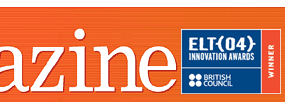|

FROM THE EDITOR
 In
this Issue In
this Issue
 Contributors Contributors
 Letters
to the Editor Letters
to the Editor
 Write
to Us Write
to Us
 Spread
the Word Spread
the Word
 Back
Issues Back
Issues
 Index Index
FEATURE
 Issues
in Business Issues
in Business
English teaching
Learner independence
in Business English
 Birthday
Greetings Birthday
Greetings
Happy birthday
MED Magazine!
COLUMNS
 Language
Interference Language
Interference
Making friends with Polish
True friends, false friends, unreliable friends and
friends in disguise
 Focus
on Language Focus
on Language
Study:
Introduction
Word formation
Compounds and acronyms
UK
version ¦ US
version
 New
words of the year New
words of the year
A review of 2004
in twelve words
 Top
Tips for Business English Top
Tips for Business English
Teaching presentation skills:
Presentation Essentials 2
Activities ¦
Teacher's
notes
 onestopenglish.com onestopenglish.com
|
 |
Top
Tips for Business English
by Rosemary
Richey
• Introduction
• Language level
• Preparations
• Language and skill
components
A Finishing
up a presentation
B General
language points
• Teaching ideas and
resources
• Next in the series
Introduction
We are continuing our series of tips for teaching typical
business skills. Following last month's tips on starting up a presentation,
part two provides language practice to finish up a presentation.
top
Language
level
The language and skills featured here are appropriate
for upper intermediate and advanced levels.
top
Preparations
| Presentations are often a problematic
area for Business English students. The learning process can be demanding
and difficult. It is important to teach presentations in a systematic,
step-by-step approach, so the students can build their confidence
in a practical way. |
| Review the overall stages
of a presentation with the students. Assign pairs one of these questions
to discuss: |
| • |
What is the reaction
of the audience when a presentation is not well-organised? |
| • |
How can eye contact
and body language affect a presentation? |
| • |
How do visual aids
enhance a presentation? |
| • |
Can you give the same
presentation to any audience? Why or why not? |
| The students share their ideas with the
whole class. This gives them a basis for considering the impact of
communication skills combined with the right language on any presentation. |
top
Language and skill
components
The following list identifies key functions and useful
language associated with presenting the main points of a presentation
to responding to comments and questions.
top
A
Finishing up a presentation
| function |
language |
| main points/USP (unique selling point) |
Our engineering designs are extraordinary because
...
The advantage of our technology is ...
These are the highlights of our engineering projects ...
The USP of HighTech Unlimited is our state-of-the-art ... |
| summarising/closing |
To conclude/wrap
up/summarise, I've
just described ...
I'll just recap on the highlights of this presentation.
As you can see ...
To sum up ...
Briefly ...
Thanks for your attention. Please pick up ... (promotion
material, samples, information) on your way
out. |
| responding to comments and questions
|
That's an interesting comment. Let me say that
...
I'd be glad to clarify that point ...
Thanks for your query. I'll have to check on that and get back to
you. I'll be interested in finding out more about this ... |
top
B
General language points
As mentioned for starting
presentations, for finishing presentations review and emphasise language
such as
| • |
use of I'd/would like to ... or I'd/would
be glad to ... |
| • |
use of the active form, i.e. not passive: Customers
give us excellent feedback on our engineering services. |
| • |
use of the present simple: Currently/Presently/At
the moment/At the present we have over 1000 customers. |
| • |
use of the past simple: Last year/Back
in 2003 we completed two major projects. |
| • |
use of the present perfect: Over the last few
month/Recently, we've seen a big increase in contracts. |
| • |
sequencing with word such as firstly, secondly,
then, next: Firstly, let me give you a quick history
of our engineering company. ... Secondly, I'll speak about ... |
Practise language for
emphasis, according to the business activity, product or service:
| • |
emphasizing: absolutely/entirely/extremely/fairly/reasonably/quite |
| • |
movement or change: to rise/rocket/boom
and to drop/decline/crash |
| • |
degree of change: dramatically/considerably/significantly/moderately/slightly |
| • |
speed of change: rapidly/quickly/suddenly/gradually/steadily/slowly |
top
Teaching ideas and
resources
Practising a complete presentation takes time and patience
from both you and your students. In the learning process, working off
checklists provides the students a sense of solid organisation. Set a
realistic time frame involving the organising and actual practice for
both inside and outside the class. Try these other miscellaneous tips:
| • |
Take language from any stage of a presentation and
make a matching exercise. Write the phrases on cards or strips and
get students to match the lexis to the appropriate stages. |
| • |
In reviewing the latter steps of a presentation,
elicit a discussion on the following questions:
How do you respond to a query when you
don't know the answer?
What happens if you tell your audience something that may not be
correct?
Why would
a presenter feel compelled to give an answer when it's really not
the truth?
|
| • |
Discuss the impact of intonation in a presentation,
focussing on the impact of having a 'monotone' speaking voice on the
audience. |
| • |
Talk about the advantages or disadvantages of reading
a presentation. Have students give their ideas about how this affects
eye contact, body language or even the language used in the presentation. |
| • |
Ideally, students should practise two different styles
of presentations i.e. an individual or group presentation along with
presentations that have a different focus such selling, informing
or persuading. |
top
In the next issue of MED Magazine you
can find some tips for teaching language and skills for negotiations.
In the meantime, I look forward to your feedback and suggestions on any
Business English concern you may have. You can contact me on this
page.
top
|





